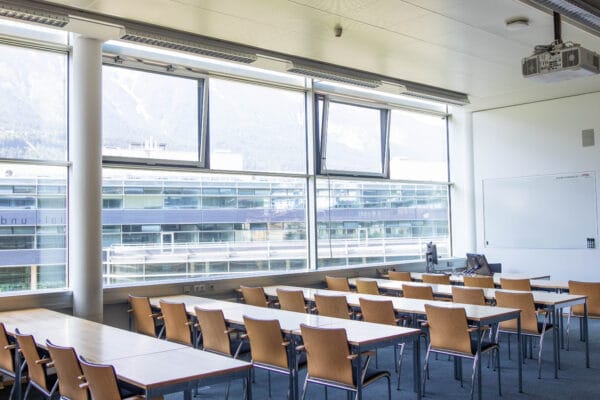
NAME:
MCI - SR 303
BUILDING:
Management Center Innsbruck
FLOOR:
3
TYPE:
Seminar Room
CAPACITY:
54
ACCESS:
Only Participants
EQUIPMENT:
Beamer, Handicapped Accessible, PC, Sound System, Whiteboard, WLAN (Eduroam), Microphones
Chile, with 68.3% of its territory covered by mountains, has experienced remarkable growth in mountain tourism in recent years. In response, various initiatives have emerged to equip the Andes with infrastructure that supports high-altitude activities.
This resurgence of mountain exploration echoes a legacy that dates back nearly a century. Driven by the desire to inhabit the mountains—just as their ancestors once did—and despite being in unfamiliar lands, European migrants to Chile brought together outdoor enthusiasts deeply passionate about exploring the Andes. Aiming to replicate Alpine mountain culture in this new territory, the emerging mountaineering community led to the creation of a lasting network of mountain refuges in the 1930s. In doing so, they established a presence in a vast, rugged landscape—a stark contrast to the serene, densely populated Alps.
Inaugurated in 1932, Chile’s first mountain refuge emerged from the efforts and initiative of members of the German Andean Club of Santiago. The construction of the Lo Valdés hut set a precedent for mountain infrastructure development, not only in the Metropolitan Region’s highlands but also further south, forming a significant network of refuges across the Southern Andes.
The landscapes surrounding these huts are vast, unbounded, and desolate, shaping the experience of those who inhabit them. United by a shared historical and geographical context, these structures are strategically placed, with the architectural form conceived as a landmark within a constantly changing environment. They stand as guiding points, marking human presence in the high Andes.
These remnants of Andean habitation are increasingly at risk, endangering both their preservation and the historical heritage and collective memory they embody. Each ruin and every stone fragment tells a story of human interaction with a challenging and majestic environment.
Constructed with locally sourced materials, each refuge merges with the rock in its uninhabited stillness, offering shelter to those who find it. In contrast to the surrounding mountains, it rises as a beacon for mountaineers who, as they navigate the immense terrain, become more than visitors—they become inhabitants of the Andes.

We and use cookies and other tracking technologies to improve your experience on our website. We may store and/or access information on a device and process personal data, such as your IP address and browsing data, for personalised advertising and content, advertising and content measurement, audience research and services development. Additionally, we may utilize precise geolocation data and identification through device scanning.
Please note that your consent will be valid across all our subdomains. You can change or withdraw your consent at any time by clicking the “Consent Preferences” button at the bottom of your screen. We respect your choices and are committed to providing you with a transparent and secure browsing experience.